Come comment on this article: Google releases Wear OS 2.1 update that focuses on swiping and gestures
Google releases Wear OS 2.1 update that focuses on swiping and gestures appeared first on http://www.talkandroid.com
Come comment on this article: Google releases Wear OS 2.1 update that focuses on swiping and gestures
Come comment on this article: Facebook used phone numbers from two-factor authentication to target users with ads
Come comment on this article: Google somehow let another major Pixel 3 leak happen, again
Blok.Party, the company the upcoming PlayTable game console, announced today raised $10 million in new funding. It’s also unveiling a big content partnership, where Blok.Party will create its own version of the popular board game Settlers of Catan.
I first wrote about Blok.Party and PlayTable earlier this year, when co-founder and CEO Jimmy Chen first laid out his vision to use blockchain technology to build a console that can recognize real-world objects (like figurines and cards), creating a hybrid between tabletop and video gaming.
The idea may have sounded a little abstract at the time, but it got a lot clearer when Chen dropped by the TechCrunch New York office to play a couple rounds of Catan with me.
I’ll admit that I hadn’t played in a while, but it was clear from the start that PlayTable saved us some setup time — instead of putting all the pieces of the physical board together, you play on a digital representation of the board. Most of the pieces are digitized too, and we used and traded our cards using smartphones. But there is a physical “robber” pieces, because Chen said this allows the robber’s movement to remain “a very visceral experience … that a digital version can’t ever capture.”
It may not be too long before you get to try this out for yourself, at least if you’re among the 100,000 pre-orders Blok.Party has received so far. Chen said the company will start shipping its first devices this fall.
He added that Catan, like many of the other games built for PlayTable, will be priced at around $20.
“For us, it’s not about trying to compete based on price,” Chen said. “We’re trying to compete based on experience.”
The new funding comes from crypto fund JRR Capital and other investors. Chen said the company will use the money to continue scaling the product, including further software development and building out the library of games.
At the same time, he emphasized that although Blok.Party is manufacturing the initial devices, his vision is to achieve real scale through partnerships with hardware manufacturers, who will build their own PlayTable consoles. Apparently, some of those discussions are already underway.
“Our strategy is to always have [our own] hardware program running to continually do research,” Chen said. “What I’ve discovered is that keeping a hardware program running is not that expensive. The expensive part is when you try to scale the program.”
Come comment on this article: LG announces the V40 ThinQ ahead of October 3rd event with a new teaser video
Come comment on this article: LG Watch Timepiece to launch alongside LG V40 ThinQ
Come comment on this article: Facebook Messenger finally gets its sleek, simplified redesign, plus a dark mode
Come comment on this article: [TA Deals] Snag a 50% discount on the Paww WaveSound 2.1 Bluetooth 4.2 headphones
Come comment on this article: [Deal] Save at least 20% on these Anker accessories (US & UK)
Fear not, citizens — the law enforcement apparatus of California has apprehended or is hot on the trail of more than a dozen hardened criminals who boldly stole from the state’s favorite local business: Apple. Their unconscionable larceny amounted to more than a million dollars’ worth of devices stolen from Apple Stores — the equivalent of hundreds of iPhones.
The alleged thieves would wear hoodies into Apple stores — already suspicious, I know — and there they would snatch products on display and hide them in the ample pockets of those garments. Truly cunning.
These crimes took place in 19 different counties in California, the police forces of which all collaborated to bring the perpetrators to justice, though the San Luis Obispo and Oakland departments led the charge. So far seven of the thieves have been arrested, and nine more have warrants out.
In a press release, California Attorney General Xavier Becerra harangued his state regarding the dangers of the criminal element:
Organized retail thefts cost California business owners millions and expose them to copycat criminals. Ultimately, consumers pay the cost of this merchandise hijacking. We will continue our work with local law enforcement authorities to extinguish this mob mentality and prosecute these criminals to hold them accountable.
You hear that, would-be copycats? You hear that, assembling mob? Xavier’s gonna give it to you… if you don’t fly straight and stop trying to stick ordinary consumers with the costs of your crimes. Not to mention California businesses. With Apple paying that $15 billion in back taxes, it doesn’t have a lot of cash to spare for these shenanigans.
Well, I suppose it’s doing okay.
I’ve asked Apple for comment on this case and whether they participated or cooperated in it. Perhaps Face ID helped.
Archaeology may not be the most likely place to find the latest in technology — AI and robots are of dubious utility in the painstaking fieldwork involved — but lidar has proven transformative. The latest accomplishment using laser-based imaging maps thousands of square kilometers of an ancient Mayan city once millions strong, but the researchers make it clear that there’s no technological substitute for experience and a good eye.
The Pacunam Lidar Initiative began two years ago, bringing together a group of scholars and local authorities to undertake the largest yet survey of a protected and long-studied region in Guatemala. Some 2,144 square kilometers of the Maya Biosphere Reserve in Petén were scanned, inclusive of and around areas known to be settled, developed, or otherwise of importance.
Preliminary imagery and data illustrating the success of the project were announced earlier this year, but the researchers have now performed their actual analyses on the data, and the resulting paper summarizing their wide-ranging results has been published in the journal Science.
“We’ve never been able to see an ancient landscape at this scale all at once. We’ve never had a dataset like this. But in February really we hadn’t done any analysis, really, in a quantitative sense,” co-author Francisco Estrada-Belli, of Tulane University, told me. He worked on the project with numerous others, including his colleagues Marcello Canuto and Stephen Houston. “Basically we announced we had found a huge urban sprawl, that we had found agricultural features on a grand scale. After another 9 months of work we were able to quantify all that and to get some numerical confirmations for the impressions we’d gotten.”
“It’s nice to be able to confirm all our claims,” he said. “They may have seemed exaggerated to some.”
The lidar data was collected not by self-driving cars, which seem to be the only vehicles bearing lidar we ever hear about, nor even by drones, but by traditional airplane. That may sound cumbersome, but the distances and landscapes involved permitted nothing else.
“A drone would never have worked — it could never have covered that area,” Estrada-Belli explained. “In our case it was actually a twin engine plane flown down from Texas.”
The plane would made dozens of passes over a given area, a chosen “polygon” perhaps 30 kilometers long and 20 wide. Mounted underneath was “a Teledyne Optech Titan MultiWave multichannel, multi-spectral, narrow-pulse width lidar system,” which pretty much says it all: this is a heavy duty instrument, the size of a refrigerator. But you need that kind of system to pierce the canopy and image the underlying landscape.
The many overlapping passes were then collated and calibrated into a single digital landscape of remarkable detail.
“It identified features that I had walked over — a hundred of times!” he laughed. “Like a major causeway, I walked over it, but it was so subtle, and it was covered by huge vegetation, underbrush, trees, you know, jungle — I’m sure that in another 20 years I wouldn’t have noticed it.”
But these structures don’t identify themselves. There’s no computer labeling system that looks at the 3D model and says, “this is a pyramid, this is a wall,” and so on. That’s a job that only archaeologists can do.
“It actually begins with manipulating the surface data,” Estrada-Belli said. “We get these surface models of the natural landscape; each pixel in the image is basically the elevation. Then we do a series of filters to simulate light being projected on it from various angles to enhance the relief, and we combine these visualizations with transparencies and different ways of sharpening or enhancing them. After all this process, basically looking at the computer screen for a long time, then we can start digitizing it.”
“The first step is to visually identify features. Of course, pyramids are easy, but there are subtler features that, even once you identify them, it’s hard to figure out what they are.”
The lidar imagery revealed, for example, lots of low linear features that could be man-made or natural. It’s not always easy to tell the difference, but context and existing scholarship fill in the gaps.
“Then we proceeded to digitize all these features… there were 61,000 structures, and everything had to be done manually,” Estrada-Belli said — in case you were wondering why it took nine months. “There’s really no automation because the digitizing has to be done based on experience. We looked into AI, and we hope that maybe in the near future we’ll be able to apply that, but for now an experienced archaeologist’s eye can discern the features better than a computer.”
You can see the density of the annotations on the maps. It should be noted that many of these features had by this point been verified by field expeditions. By consulting existing maps and getting ground truth in person, they had made sure that these weren’t phantom structures or wishful thinking. “We’re confident that they’re all there,” he told me.
[gallery ids="1721959,1721960,1721957,1721961,1721958"]“Next is the quantitative step,” he continued. “You measure the length and the areas and you put it all together, and you start analyzing them like you’d analyze other dataset: the structure density of some area, the size of urban sprawl or agricultural fields. Finally we even figured a way to quantify the potential production of agriculture.”
This is the point where the imagery starts to go from point cloud to academic study. After all, it’s well known that the Maya had a large city in this area; it’s been intensely studied for decades. But the Pacunam (which stands for Patrimonio Cultural y Natural Maya) study was meant to advance beyond the traditional methods employed previously.
“It’s a huge dataset. It’s a huge cross section of the Maya lowlands,” Estrada-Belli said. “Big data is the buzzword now, right? You truly can see things that you would never see if you only looked at one site at a time. We could never have put together these grand patterns without lidar.”
“For example, in my area, I was able to map 47 square kilometers over the course of 15 years,” he said, slightly wistfully. “And in two weeks the lidar produced 308 square kilometers, to a level of detail that I could never match.”
As a result the paper includes all kinds of new theories and conclusions, from population and economy estimates, to cultural and engineering knowledge, to the timing and nature of conflicts with neighbors.
The resulting report doesn’t just advance the knowledge of Mayan culture and technology, but the science of archaeology itself. It’s iterative, of course, like everything else — Estrada-Belli noted that they were inspired by work done by colleagues in Belize and Cambodia; their contribution, however, exemplifies new approaches to handling large areas and large datasets.
The more experiments and field work, the more established these methods will become, and the greater they will be accepted and replicated. Already they have proven themselves invaluable, and this study is perhaps the best example of lidar’s potential in the field.
“We simply would not have seen these massive fortifications. Even on the ground, many of their details remain unclear. Lidar makes most human-made features clear, coherent, understandable,” explained co-author Stephen Houston (also from Tulane) in an email. “AI and pattern recognition may help to refine the detection of features, and drones may, we hope, bring down the cost of this technology.”
“These technologies are important not only for discovery, but also for conservation,” pointed out co-author Thomas Garrison in an email. “3D scanning of monuments and artifacts provide detailed records and also allow for the creation of replicas via 3D printing.”
Lidar imagery can also show the extent of looting, he wrote, and help cultural authorities provide against it by being aware of relics and sites before the looters are.
The researchers are already planning a second, even larger set of flyovers, founded on the success of the first experiment. Perhaps by the time the initial physical work is done the trendier tools of the last few years will make themselves applicable.
“I doubt the airplanes are going to get less expensive but the instruments will be more powerful,” Estrada-Belli suggested. “The other line is the development of artificial intelligence that can speed up the project; at least it can rule out areas, so we don’t waste any time, and we can zero in on the areas with the greatest potential.”
He’s also excited by the idea of putting the data online so citizen archaeologists can help pore over it. “Maybe they don’t have the same experience we do, but like artificial intelligence they can certainly generate a lot of good data in a short time,” he said.
But as his colleagues point out, even years in this line of work are necessarily preliminary.
“We have to emphasize: it’s a first step, leading to innumerable ideas to test. Dozens of doctoral dissertations,” wrote Houston. “Yet there must always be excavation to look under the surface and to extract clear dates from the ruins.”
“Like many disciplines in the social sciences and humanities, archaeology is embracing digital technologies. Lidar is just one example,” wrote Garrison. “At the same time, we need to be conscious of issues in digital archiving (particularly the problem of obsolete file formatting) and be sure to use technology as a complement to, and not a replacement for methods of documentation that have proven tried and true for over a century.”
The researchers’ paper was published today in Science; you can learn about their conclusions (which are of more interest to the archaeologists and anthropologists among our readers) there, and follow other work being undertaken by the Fundación Pacunam at its website.
Come comment on this article: [TA Deals] Become a spreadsheet expert with the discounted Excel and Sheets Mastery Bundle
Come comment on this article: Oppo Find X will be the world’s first phone with 10GB of RAM, because why not?
Come comment on this article: Sony gives in, will allow Fortnite crossplay on the PS4
Come comment on this article: Huawei Y9 review: Quality hardware and killer battery life at an affordable price
Come comment on this article: Say hello to the LG V40 ThinQ and it’s triple camera system
Come comment on this article: Samsung Galaxy P30 gets detailed, including size and color options, plus an in-screen fingerprint scanner
Come comment on this article: [TA Deals] Get ITIL-certified and kickstart your career with our discounted training bundle!
If you’re familiar with 20th century Soviet camera clones you’ll probably be familiar with Zenit. Created by Krasnogorsky Zavod, the Nikon/Leica clones were a fan favorite behind the Iron Curtain and, like the Lomo, was a beloved brand that just doesn’t get its due. The firm stopped making cameras in 2005 but in its long history it defined Eastern European photography for decades and introduced the rifle-like Photo Sniper camera looked like something out of James Bond.
Now, thanks to a partnership with Leica, Zenit is back and is here to remind you that in Mother Russia, picture takes you.
The camera is based on the Leica M Type 240 platform but has been modified to look and act like an old Zenit. It comes with a Zenitar 35 mm f/1.0 lens that is completely Russian-made. You can use it for bokeh and soft-focus effects without digital processing.
The Leica M platform offers a 24MP full-frame CMOS sensor, a 3-inch LCD screen, HD video recording, live view focusing, a 0.68x viewfinder, ISO 6400, and 3fps continuous shooting. It will be available this year in the US, Europe, and Russia.
How much does the privilege of returning to the past cost? An estimated $5,900-$7,000 if previous incarnations of the Leica M are any indication. I have a few old film Zenits lying around the house, however. I wonder I can stick in some digital guts and create the ultimate Franken-Zenit?
Come comment on this article: Google Lens to intertwine with Google Camera for real-time help on Google Pixel 3 phones
Come comment on this article: Samsung Experience 10 Launcher is available for Samsung devices on Android Oreo and up
Come comment on this article: Plan your group trips with Google Maps and a new voting function
Come comment on this article: Google’s Pixel Stand leaks again – could support fast wireless charging
While this video shows a tiny robot from the City University of Hong Kong doing what amounts to a mitzvah, we can all imagine a future in which this little fellow could stab you in the kishkes.
This wild little robot uses electromagnetic force to swim or flop back and forth to pull itself forward through harsh environments. Researchers can remotely control it from outside of the body.
“Most animals have a leg-length to leg-gap ratio of 2:1 to 1:1. So we decided to create our robot using 1:1 proportion,” said Dr. Shen Yajing of CityU’s Department of Biomedical Engineering.
The legs are .65 mm long and pointed, reducing friction. The robot is made of “silicon material called polydimethylsiloxane (PDMS) embedded with magnetic particles which enables it to be remotely controlled by applying electromagnetic force.” It can bend almost 90 degrees to climb over obstacles.
The researchers have sent the little fellow through multiple rough environments including this wet model of a stomach. It can also carry medicines and drop them off as needed.
“The rugged surface and changing texture of different tissues inside the human body make transportation challenging. Our multi-legged robot shows an impressive performance in various terrains and hence open wide applications for drug delivery inside the body,” said Professor Wang Zuankai.
The team hopes to create a biodegradable robot in the future which would allow the little fellow to climb down your esophagus and into your guts and then, when it has dropped its payload, dissolve into nothingness or come out your tuchus.
GoPro’s stock price is on a bit of rebound this morning. The stock opened at $7.36, up from its previous close of $6.62, and is continuing to climb on news that Oppenheimer analyst Andrew Uerkwitz is now bullish on the action camera maker. He cites optimism around GoPro’s refreshed product line.
Uerkwitz changed his rating on the company from perform to outperform and issued a stock price target of $9, up 36% from GoPro’s most recent close of $6.62. GoPro last traded at $9 a share in November 2017.
GoPro’s latest products bring improved mechanics and additional features to the action cameras. The new flagship model retails for $400 and includes built-in stabilization and the ability to live stream video to the internet. The company also introduced two less expensive cameras and cancelled the GoPro Session product line. The new offering is streamlined and cohesive.
The Oppenheimer analyst seeming agrees, writing to clients “With compelling features such as live streaming and gimbal-like image stabilization, we believe the products are compelling” and adding “In summary, overlooked GoPro should be a buy.”
Reports are coming in that Amazon’s Alexa service is down in parts of UK, Spain, Germany and Austria. According to Down Detector and Twitter, the problem started surfacing around 8am local time and still continues. Interestingly, some users are reporting the issue is isolated to Echo Dot 2 models and while other Echo devices are still working. Sometimes. Other reports say everything is down. When users try to talk to their Echo devices, Alexa will report an error with connectivity and spin a red ring around the top.
Because of this outage, users will have to use wall switches to turn on lights, press buttons to make coffee and look outside to assess the weather.
As Engadget points out in their coverage, the outage could stem from Amazon Web Service issues at the company’s Ireland facility. Amazon is now reporting that those issues have been resolved so there’s a chance Alexa will be coming back online shortly.
Come comment on this article: Plex is adding easy subtitle support for your favorite movies, but dropped some little used features
The new iPhones have excellent cameras, to be sure. But it’s always good to verify Apple’s breathless on-stage claims with first-hand reports. We have our own review of the phones and their photography systems, but teardowns provide the invaluable service of letting you see the biggest changes with your own eyes — augmented, of course, by a high-powered microscope.
We’ve already seen iFixit’s solid-as-always disassembly of the phone, but TechInsights gets a lot closer to the device’s components — including the improved camera of the iPhone XS and XS Max.
Although the optics of the new camera are as far as we can tell unchanged since the X, the sensor is a new one and is worth looking closely at.
Microphotography of the sensor die show that Apple’s claims are borne out and then some. The sensor size has increased from 32.8mm2 to 40.6mm2 — a huge difference despite the small units. Every tiny bit counts at this scale. (For comparison, the Galaxy S9 is 45mm2, and the soon-to-be-replaced Pixel 2 is 25mm2.)
The pixels themselves also, as advertised, grew from 1.22 microns (micrometers) across to 1.4 microns — which should help with image quality across the board. But there’s an interesting, subtler development that has continually but quietly changed ever since its introduction: the “focus pixels.”
That’s Apple’s brand name for phase detection autofocus (PDAF) points, found in plenty of other devices. The basic idea is that you mask off half a sub-pixel every once in a while (which I guess makes it a sub-sub-pixel), and by observing how light enters these half-covered detectors you can tell whether something is in focus or not.
Of course, you need a bunch of them to sense the image patterns with high fidelity, but you have to strike a balance: losing half a pixel may not sound like much, but if you do it a million times, that’s half a megapixel effectively down the drain. Wondering why that all the PDAF points are green? Many camera sensors use an “RGBG” sub-pixel pattern, meaning there are two green sub-pixels for each red and blue one — it’s complicated why. But there are twice as many green sub-pixels and therefore the green channel is more robust to losing a bit of information.
Apple introduced PDAF in the iPhone 6, but as you can see in TechInsights’ great diagram, the points are pretty scarce. There’s one for maybe every 64 sub-pixels, and not only that, they’re all masked off in the same orientation: either the left or right half gone.
The 6S and 7 Pluses saw the number double to one PDAF point per 32 sub-pixels. And in the 8 Plus, the number is improved to one per 20 — but there’s another addition: now the phase detection masks are on the tops and bottoms of the sub-pixels as well. As you can imagine, doing phase detection in multiple directions is a more sophisticated proposal, but it could also significantly improve the accuracy of the process. Autofocus systems all have their weaknesses, and this may have addressed one Apple regretted in earlier iterations.
Which brings us to the XS (and Max, of course), in which the PDAF points are now one per 16 sub-pixels, having increased the frequency of the vertical phase detection points so that they’re equal in number to the horizontal one. Clearly the experiment paid off and any consequent light loss has been mitigated or accounted for.
I’m curious how the sub-pixel patterns of Samsung, Huawei, and Google phones compare, and I’m looking into it. But I wanted to highlight this interesting little evolution. It’s an interesting example of the kind of changes that are hard to understand when explained in simple number form — we’ve doubled this, or there are a million more of that — but which make sense when you see them in physical form.
Come comment on this article: Android Messages picks up some improved search functionality
Photokina is underway in London and the theme of the show is “large.” Unusually for an industry that is trending towards the compact, the cameras on stage at this show sport big sensors, big lenses, and big price tags. But though they may not be for the average shooter, these cameras are impressive pieces of hardware that hint at things to come for the industry as a whole.
The most exciting announcement is perhaps that from Panasonic, which surprised everyone with the S1 and S1R, a pair of not-quite-final full frame cameras that aim to steal a bit of the thunder from Canon and Nikon’s entries into the mirrorless full frame world.
Panasonic’s cameras have generally had impressive video performance, and these are no exception. They’ll shoot 4K at 60 FPS, which in a compact body like that shown is going to be extremely valuable to videographers. Meanwhile the S1R, with 47 megapixels to the S1’s 24, will be optimized for stills. Both will have dual card slots (which Canon and Nikon declined to add to their newest gear), weather sealing, and in-body image stabilization.
The timing and inclusion of so many desired features indicates either that Panasonic was clued in to what photographers wanted all along, or they waited for the other guys to move and then promised the things their competitors wouldn’t or couldn’t. Whatever the case, the S1 and S1R are sure to make a splash, whatever their prices.
Panasonic was also part of an announcement that may have larger long-term implications: a lens mount collaboration with Leica and Sigma aimed at maximum flexibility for the emerging mirrorless full-frame and medium format market. L-mount lenses will work on any of the group’s devices (including the S1 and S1R) and should help promote usage across the board.
Leica, for its part, announced the S3, a new version of its medium format S series that switches over to the L-mount system as well as bumping a few specs. No price yet but if you have to ask, you probably can’t afford it.
Sigma had no camera to show, but announced it would be taking its Foveon sensor tech to full frame and that upcoming bodies would be using the L mount as well.

This Fuji looks small here, but it’s no lightweight. It’s only small in comparison to previous medium format cameras.
Fujifilm made its own push on the medium format front with the new GFX 50R, which sticks a larger than full frame (but smaller than “traditional” medium format) sensor inside an impressively small body. That’s not to say it’s insubstantial: Fuji’s cameras are generally quite hefty, and the 50R is no exception, but it’s much smaller and lighter than its predecessor and, surprisingly, costs $2,000 less at $4,499 for the body.
The theme, as you can see, is big and expensive. But the subtext is that these cameras are not only capable of extraordinary imagery, but they don’t have to be enormous to do it. This combination of versatility with portability is one of the strengths of the latest generation of cameras, and clearly Fuji, Panasonic and Leica are eager to show that it extends to the pro-level, multi-thousand dollar bodies as well as the consumer and enthusiast lineup.
Come comment on this article: [TA Deals] Save over 90% on a lifetime VPN Unlimited subscription!
Come comment on this article: Google Feed gets a new name – Discover – to go with all the changes
Come comment on this article: Google Pixel 3 wallpapers have leaked, and you can grab them here
If you’ve been keeping up with watchmaker MB&F you’ll be familiar with their Horological Machine series, watches that are similar in construction but wildly differ when it comes to design. This watch, the HM9, is called the Flow and hearkens back to roadsters, jets, and 1950s space ships.
[gallery ids="1719823,1719822,1719821"]The watch, limited to a run of 33 pieces, shows the time on a small forward-facing face in one of the cones. The other two cones contain dual balance wheels. The balance wheel is what causes the watch to tick and controls the energy released by the main spring. Interestingly, MB&F added two to this watch in an effort to ensure accuracy. “The twin balance wheels of the HM9 engine feed two sets of chronometric data to a central differential for an averaged reading,” they wrote. “The balances are individually impulsed and spatially separated to ensure that they beat at their own independent cadences of 2.5Hz (18,000bph) each. This is important to ensure a meaningful average, just as how a statistically robust mathematical average should be derived from discrete points of information.”
There are two versions called the Road and Air and they cost a mere $182,000 (tax not included.) Considering nearly every piece of this is made by hand – from the case to the curved crystal to the intricate movement – you’re essentially paying a team of craftsman a yearly wage just to build your watch.
While it’s no Apple Watch, the MB&F HM9 is a unique and weird little timepiece. While it’s obviously not for everyone, with enough cash and a little luck you can easily join a fairly exclusive club of HM9 owners.
Come comment on this article: Check out the Huawei Mate 20 Pro with triple cameras and a slick paint job
Whether you’re trying to figure out how many students are attending your lectures or how many evil aliens have taken your Space Force brethren hostage, Wi-Fi can now be used to count them all.
The system, created by researchers at UC Santa Barbara, uses a single Wi-Fi router outside of the room to measure attenuation and signal drops. From the release:
The transmitter sends a wireless signal whose received signal strength (RSSI) is measured by the receiver. Using only such received signal power measurements, the receiver estimates how many people are inside the room — an estimate that closely matches the actual number. It is noteworthy that the researchers do not do any prior measurements or calibration in the area of interest; their approach has only a very short calibration phase that need not be done in the same area.
This means that you could simply walk up to a wall and press a button to count, with a high degree of accuracy, how many people are walking around. The system can measure up to 20 people in its current form.
The system uses a mathematical model to “see” people in the room based on signal strength and attenuation. The system uses off-the-shelf components and they’ve tested it in multiple locations and found that their total accuracy is two people or less with only one Wi-Fi device nearby.
Bodies and objects essentially absorb Wi-Fi as they move around in rooms, allowing the system to find discrete things in the space. Sadly it can’t yet map their position in the room, a feature that could be even more helpful in the future.
Come comment on this article: Roku now has some of the cheapest 4K streaming players ever
Dust off your old Bose 501 speakers. New devices are coming that will give traditional audio equipment a voice.
Amazon recently announced a mess of new Echo devices and among the lot are several small, diminutive add-ons. These models did not have a smart speaker built into the devices but rather turned other speakers into smart speakers.
Sonos has a similar device too. Called the Sonos Amp, the device connects the Sonos service to audio receivers and can drive traditional speakers. There’s a new version coming out in 2019 that adds Alexa and AirPlay 2.
This movement back towards traditional speaker systems could be a boon for audio companies reeling from the explosion of smart speakers. Suddenly, consumers do not have to choose between the ease of use in an inexpensive smart speaker and the vastly superior audio quality of a pair of high-end speakers. Consumers can have voice services and listen to Cake too.
Echo devices are everywhere in my house. They’re in three bedrooms, my office, our living room, my workshop and outside on the deck. But besides the Tap in the workshop and Echo in the kitchen, every Echo is connected to an amp and speakers. For instance, in my office, I have an Onkyo receiver and standalone Onkyo amp that powers a pair of Definitive Technology bookshelf speakers. The bedrooms have various speakers connected to older A/V receivers. Outside there’s a pair of Yamaha speakers powered by cheap mini-amp. Each system sounds dramatically better than any smart speaker available.
There’s a quiet comfort in building an audio system: To pick out each piece and connect everything; to solder banana clips to speaker wire and ensure the proper power is flowing to each speaker.
Amazon and Google built one of the best interfaces for audio in Alexa and Google Assistant. But that could change in the future. In the end, Alexa and Google Assistant are just another component in an audio stack, and to some consumers, it makes sense to treat them as a turntable or equalizer — a part that can be swapped out in the future.
The world of consumer electronics survives because of the disposable nature of gadgets. There’s always something better coming soon. Cell phones last a couple years and TVs last a few years longer. But bookshelf speakers purchased today will still sound great in 20 years.
There’s a thriving secondary market for vintage audio equipment, and unlike old computer equipment, buyers want this gear actually to use it.
If you see a pair of giant Bose speakers at a garage sale, buy them and use them. Look at the prices for used Bose 901 speakers: they’re the cost of three Apple HomePods. Look at ShopGoodwill.com — Goodwill’s fantastic auction site. It’s filled with vintage audio equipment with some pieces going for multiple thousands of dollars. Last year’s smart speakers are on there, too, available for pennies on the dollar.
For the most part, audio equipment will last generations. Speakers can blow and wear out. Amps can get hit by surges and components can randomly fail. It happens, but most of the time, speakers survive.
This is where Amazon and Sonos come in. Besides selling standalone speakers, both companies have products available that adds services to independent speaker systems. A person doesn’t have to ditch their Pioneer stack to gain access to Alexa. They have to plug in a new component, and in the future, if something better is available, that component can be swapped out for something else.
Amazon first introduced this ability in the little Echo Dot. The $50 speaker has a 3.5mm output that makes it easy to add to a speaker system. A $35 version is coming soon that lacks the speaker found in the Dot and features a 3.5mm output. It’s set to be the easiest and cheapest way to add voice services to speakers.
Amazon and Sonos also have higher-end components nearing release. The Amazon Echo Link features digital and discrete audio outputs that should result in improved audio. The Amazon Echo Amp adds an amplifier to power a set of passive speakers directly. Sonos offers something similar in the upcoming Sonos Amp with 125 watts per channel and HDMI to allow it to be connected to a TV.
These add-on products give consumers dramatically more options than a handful of plastic smart speakers.
There are several ways to take advantage of these components. The easiest is to look at powered speakers. These speakers have built-in amplifiers and unlike traditional speakers, plug into an outlet for power. Look at models from Edifier, Klipsch or Yamaha. Buyers just need to connect a few cables to have superior sound to most smart speakers.
Another option is to piece together a component system. Pick any A/V receiver and add a couple of speakers and a subwoofer. This doesn’t have to be expensive. Small $30 amps like from Lepy or Pyle can drive a set of speakers — that’s what I use to drive outdoor speakers. Or, look at Onkyo or Denon A/V surround sound receivers and build a home theater system and throw in an Amazon Echo Link on top. As for speakers Polk, Klipsch, Definitive Technology, KEF, B&W, and many more produce fantastic speakers that will still work years after Amazon stops making Echo devices.
Best of all, both options are modular and allows owners to modify the system overtime. Want to add a turntable? Just plug it in. That’s not possible with a Google Home.
Technology doesn’t have to be disposable.
These add-on products offer the same solution as Roku or Fire TV devices — just plug in this device to add new tricks to old gear. When it gets old, don’t throw out the TV (or in this case speakers), just plug in the latest dongle.
Sure, it’s easy to buy a Google Home Max, and the speaker sounds great, too. For some people, it’s the perfect way to get Spotify in their living space. It’s never been easier to listen to music or NPR.
There are a few great options for smart speakers. The $350 Apple HomePod sounds glorious though Siri lacks a lot of smarts of Alexa or Google Assistant. I love the Echo Dot for its utility and price point, and in a small space, it sounds okay. For my money, the best smart speaker is the Sonos One. It sounds great, is priced right, and Sonos has the best ecosystem available.
I’m excited about Amazon’s Echo and Sub bundle. For $249, buyers get two Echos and the new Echo Sub. The software forces the two Echos to work in stereo while the new subwoofer supplements the low-end. I haven’t heard the system yet, but I expect it to sound as good as the Google Home Max or Apple HomePod and the separate component operation should help the audio fill larger spaces.
Sonos has similar systems available. The fantastic Sonos One speaker can be used as a standalone speaker, part of a multiroom system, or as a surround speaker with other Sonos One speakers and the Sonos Beam audio bar. To me, Sonos is compelling because of their ecosystem and tendency to have a longer product refresh cycle. In the past, Sonos has been much slower to roll out new products but instead added services to existing products. The company seems to respect the owners of its products rather than forcing them to buy new products to gain new abilities.
In the end, though, smart speakers from Apple, Sonos, Google or Amazon will stop working. Eventually, the company will stop supporting the services powering the speakers and owners will throw the speakers in the trash. It’s depressing in the same way Spotify is depressing. Your grandkids are not going to dig through your digital Spotify milk crate. When the service is gone, the playlists are gone.
That’s the draw of component audio equipment. A turntable purchased in the ’70s could still work today. Speakers bought during the first dot-com boom will still pound when the cryptocurrency bubble pops. As for Amazon Alexa and Google Assistant, to me, it makes sense to treat it as another component in a larger system and enjoy it while it lasts.
Come comment on this article: MetroPCS rebrands as simply Metro with new plans and features
The iPhone XS proves one thing definitively: that the iPhone X was probably one of the most ambitious product bets of all time.
When Apple told me in 2017 that they put aside plans for the iterative upgrade that they were going to ship and went all in on the iPhone X because they thought they could jump ahead a year, they were not blustering. That the iPhone XS feels, at least on the surface, like one of Apple’s most “S” models ever is a testament to how aggressive the iPhone X timeline was.
I think there will be plenty of people who will see this as a weakness of the iPhone XS, and I can understand their point of view. There are about a half-dozen definitive improvements in the XS over the iPhone X, but none of them has quite the buzzword-worthy effectiveness of a marquee upgrade like 64-bit, 3D Touch or wireless charging — all benefits delivered in previous “S” years.
That weakness, however, is only really present if you view it through the eyes of the year-over-year upgrader. As an upgrade over an iPhone X, I’d say you’re going to have to love what they’ve done with the camera to want to make the jump. As a move from any other device, it’s a huge win and you’re going head-first into sculpted OLED screens, face recognition and super durable gesture-first interfaces and a bunch of other genre-defining moves that Apple made in 2017, thinking about 2030, while you were sitting back there in 2016.
Since I do not have an iPhone XR, I can’t really make a call for you on that comparison, but from what I saw at the event and from what I know about the tech in the iPhone XS and XS Max from using them over the past week, I have some basic theories about how it will stack up.
For those with interest in the edge of the envelope, however, there is a lot to absorb in these two new phones, separated only by size. Once you begin to unpack the technological advancements behind each of the upgrades in the XS, you begin to understand the real competitive edge and competence of Apple’s silicon team, and how well they listen to what the software side needs now and in the future.
Whether that makes any difference for you day to day is another question, one that, as I mentioned above, really lands on how much you like the camera.
But first, let’s walk through some other interesting new stuff.
As is always true with my testing methodology, I treat this as anyone would who got a new iPhone and loaded an iCloud backup onto it. Plenty of other sites will do clean room testing if you like comparison porn, but I really don’t think that does most folks much good. By and large most people aren’t making choices between ecosystems based on one spec or another. Instead, I try to take them along on prototypical daily carries, whether to work for TechCrunch, on vacation or doing family stuff. A foot injury precluded any theme parks this year (plus, I don’t like to be predictable) so I did some office work, road travel in the center of California and some family outings to the park and zoo. A mix of uses cases that involves CarPlay, navigation, photos and general use in a suburban environment.

In terms of testing locale, Fresno may not be the most metropolitan city, but it’s got some interesting conditions that set it apart from the cities where most of the iPhones are going to end up being tested. Network conditions are pretty adverse in a lot of places, for one. There’s a lot of farmland and undeveloped acreage and not all of it is covered well by wireless carriers. Then there’s the heat. Most of the year it’s above 90 degrees Fahrenheit and a good chunk of that is spent above 100. That means that batteries take an absolute beating here and often perform worse than other, more temperate, places like San Francisco. I think that’s true of a lot of places where iPhones get used, but not so much the places where they get reviewed.
That said, battery life has been hard to judge. In my rundown tests, the iPhone XS Max clearly went beast mode, outlasting my iPhone X and iPhone XS. Between those two, though, it was tougher to tell. I try to wait until the end of the period I have to test the phones to do battery stuff so that background indexing doesn’t affect the numbers. In my ‘real world’ testing in the 90+ degree heat around here, iPhone XS did best my iPhone X by a few percentage points, which is what Apple does claim, but my X is also a year old. The battery didn’t fail during even intense days of testing with the XS.
In terms of storage I’m tapping at the door of 256GB, so the addition of 512GB option is really nice. As always, the easiest way to determine what size you should buy is to check your existing free space. If you’re using around 50% of what your phone currently has, buy the same size. If you’re using more, consider upgrading because these phones are only getting faster at taking better pictures and video and that will eat up more space.

The review units I was given both had the new gold finish. As I mentioned on the day, this is a much deeper, brassier gold than the Apple Watch Edition. It’s less ‘pawn shop gold’ and more ‘this is very expensive’ gold. I like it a lot, though it is hard to photograph accurately — if you’re skeptical, try to see it in person. It has a touch of pink added in, especially as you look at the back glass along with the metal bands around the edges. The back glass has a pearlescent look now as well, and we were told that this is a new formulation that Apple created specifically with Corning. Apple says that this is the most durable glass ever in a smartphone.
My current iPhone has held up to multiple falls over 3 feet over the past year, one of which resulted in a broken screen and replacement under warranty. Doubtless multiple YouTubers will be hitting this thing with hammers and dropping it from buildings in beautiful Phantom Flex slo-mo soon enough. I didn’t test it. One thing I am interested in seeing develop, however, is how the glass holds up to fine abrasions and scratches over time.
My iPhone X is riddled with scratches both front and back, something having to do with the glass formulation being harder, but more brittle. Less likely to break on impact but more prone to abrasion. I’m a dedicated no-caser, which is why my phone looks like it does, but there’s no way for me to tell how the iPhone XS and XS Max will hold up without giving them more time on the clock. So I’ll return to this in a few weeks.
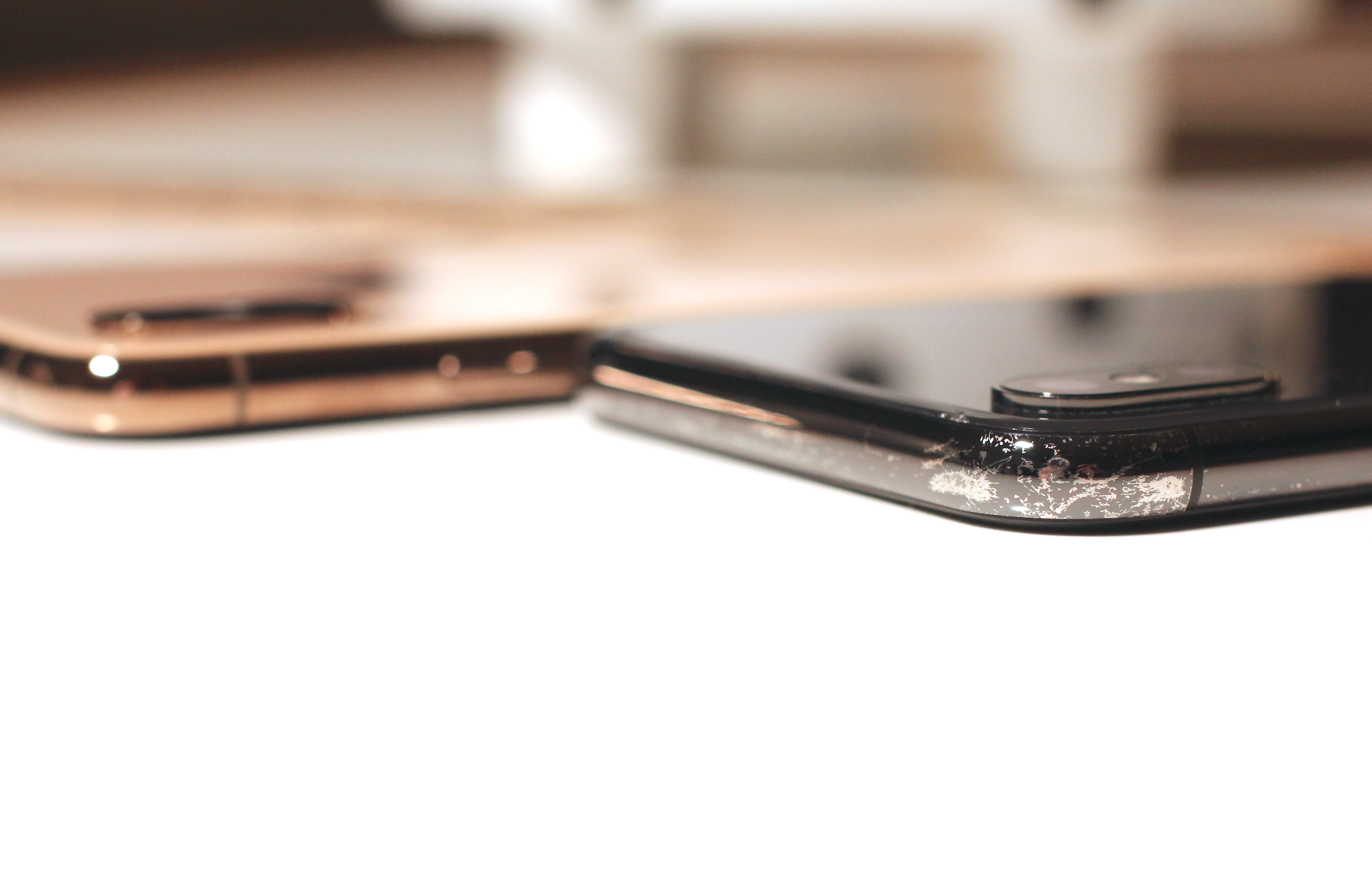
Both the gold and space grey iPhones XS have been subjected to a coating process called physical vapor deposition or PVD. Basically metal particles get vaporized and bonded to the surface to coat and color the band. PVD is a process, not a material, so I’m not sure what they’re actually coating these with, but one suggestion has been Titanium Nitride. I don’t mind the weathering that has happened on my iPhone X band, but I think it would look a lot worse on the gold, so I’m hoping that this process (which is known to be incredibly durable and used in machine tooling) will improve the durability of the band. That said, I know most people are not no-casers like me so it’s likely a moot point.
Now let’s get to the nut of it: the camera.
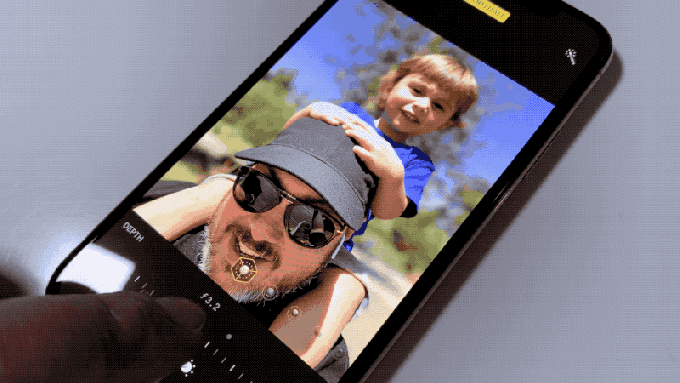
I’m (still) not going to be comparing the iPhone XS to an interchangeable lens camera because portrait mode is not a replacement for those, it’s about pulling them out less. That said, this is closest its ever been.
One of the major hurdles that smartphone cameras have had to overcome in their comparisons to cameras with beautiful glass attached is their inherent depth of focus. Without getting too into the weeds (feel free to read this for more), because they’re so small, smartphone cameras produce an incredibly compressed image that makes everything sharp. This doesn’t feel like a portrait or well composed shot from a larger camera because it doesn’t produce background blur. That blur was added a couple of years ago with Apple’s portrait mode and has been duplicated since by every manufacturer that matters — to varying levels of success or failure.
By and large, most manufacturers do it in software. They figure out what the subject probably is, use image recognition to see the eyes/nose/mouth triangle is, build a quick matte and blur everything else. Apple does more by adding the parallax of two lenses OR the IR projector of the TrueDepth array that enables Face ID to gather a multi-layer depth map.
As a note, the iPhone XR works differently, and with fewer tools, to enable portrait mode. Because it only has one lens it uses focus pixels and segmentation masking to ‘fake’ the parallax of two lenses.
With the iPhone XS, Apple is continuing to push ahead with the complexity of its modeling for the portrait mode. The relatively straightforward disc blur of the past is being replaced by a true bokeh effect.
Background blur in an image is related directly to lens compression, subject-to-camera distance and aperture. Bokeh is the character of that blur. It’s more than just ‘how blurry’, it’s the shapes produced from light sources, the way they change throughout the frame from center to edges, how they diffuse color and how they interact with the sharp portions of the image.

Bokeh is to blur what seasoning is to a good meal. Unless you’re the chef, you probably don’t care what they did you just care that it tastes great.
Well, Apple chef-ed it the hell up with this. Unwilling to settle for a templatized bokeh that felt good and leave it that, the camera team went the extra mile and created an algorithmic model that contains virtual ‘characteristics’ of the iPhone XS’s lens. Just as a photographer might pick one lens or another for a particular effect, the camera team built out the bokeh model after testing a multitude of lenses from all of the classic camera systems.
I keep saying model because it’s important to emphasize that this is a living construct. The blur you get will look different from image to image, at different distances and in different lighting conditions, but it will stay true to the nature of the virtual lens. Apple’s bokeh has a medium-sized penumbra, spreading out light sources but not blowing them out. It maintains color nicely, making sure that the quality of light isn’t obscured like it is with so many other portrait applications in other phones that just pick a spot and create a circle of standard gaussian or disc blur.

Check out these two images, for instance. Note that when the light is circular, it retains its shape, as does the rectangular light. It is softened and blurred, as it would when diffusing through the widened aperture of a regular lens. The same goes with other shapes in reflected light scenarios.

Now here’s the same shot from an iPhone X, note the indiscriminate blur of the light. This modeling effort is why I’m glad that the adjustment slider proudly carries f-stop or aperture measurements. This is what this image would look like at a given aperture, rather than a 0-100 scale. It’s very well done and, because it’s modeled, it can be improved over time. My hope is that eventually, developers will be able to plug in their own numbers to “add lenses” to a user’s kit.
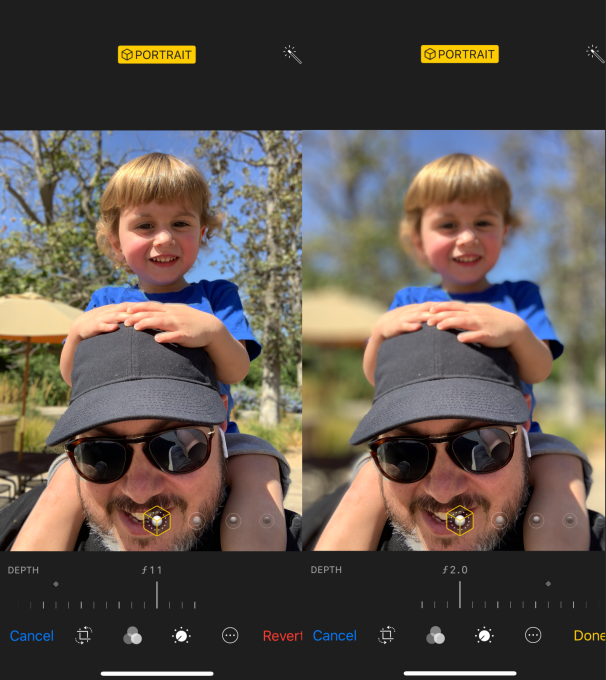
And an adjustable depth of focus isn’t just good for blurring, it’s also good for un-blurring. This portrait mode selfie placed my son in the blurry zone because it focused on my face. Sure, I could turn the portrait mode off on an iPhone X and get everything sharp, but now I can choose to “add” him to the in-focus area while still leaving the background blurry. Super cool feature I think is going to get a lot of use.
It’s also great for removing unwanted people or things from the background by cranking up the blur.

And yes, it works on non-humans.
If you end up with an iPhone XS, I’d play with the feature a bunch to get used to what a super wide aperture lens feels like. When its open all the way to f1.4 (not the actual widest aperture of the lens, by the way; this is the virtual model we’re controlling) pretty much only the eyes should be in focus. Ears, shoulders, maybe even nose could be out of the focus area. It takes some getting used to but can produce dramatic results.

A 150% crop of a larger photo to show detail preservation.
Developers do have access to one new feature though, the segmentation mask. This is a more precise mask that aids in edge detailing, improving hair and fine line detail around the edges of a portrait subject. In my testing it has led to better handling of these transition areas and less clumsiness. It’s still not perfect, but it’s better. And third-party apps like Halide are already utilizing it. Halide’s co-creator, Ben Sandofsky, says they’re already seeing improvements in Halide with the segmentation map.
“Segmentation is the ability to classify sets of pixels into different categories,” says Sandofsky. “This is different than a “Hot dog, not a hot dog” problem, which just tells you whether a hot dog exists anywhere in the image. With segmentation, the goal is drawing an outline over just the hot dog. It’s an important topic with self driving cars, because it isn’t enough to tell you there’s a person somewhere in the image. It needs to know that person is directly in front of you. On devices that support it, we use PEM as the authority for what should stay in focus. We still use the classic method on old devices (anything earlier than iPhone 8), but the quality difference is huge.”

The above is an example shot in Halide that shows the image, the depth map and the segmentation map.
My testing of portrait mode on the iPhone XS says that it is massively improved, but that there are still some very evident quirks that will lead to weirdness in some shots like wrong things made blurry and halos of light appearing around subjects. It’s also not quite aggressive enough on foreground objects — those should blur too but only sometimes do. But the quirks are overshadowed by the super cool addition of the adjustable background blur. If conditions are right it blows you away. But every once in a while you still get this sense like the Neural Engine just threw up its hands and shrugged.
Live preview of the depth control in the camera view is not in iOS 12 at the launch of the iPhone XS, but it will be coming in a future version of iOS 12 this fall.
I also shoot a huge amount of photos with the telephoto lens. It’s closer to what you’d consider to be a standard lens on a camera. The normal lens is really wide and once you acclimate to the telephoto you’re left wondering why you have a bunch of pictures of people in the middle of a ton of foreground and sky. If you haven’t already, I’d say try defaulting to 2x for a couple of weeks and see how you like your photos. For those tight conditions or really broad landscapes you can always drop it back to the wide. Because of this, any iPhone that doesn’t have a telephoto is a basic non-starter for me, which is going to be one of the limiters on people moving to iPhone XR from iPhone X, I believe. Even iPhone 8 Plus users who rely on the telephoto I believe will miss it if they don’t go to the XS.
But, man, Smart HDR is where it’s at
I’m going to say something now that is surely going to cause some Apple followers to snort, but it’s true. Here it is:
For a company as prone to hyperbole and Maximum Force Enthusiasm about its products, I think that they have dramatically undersold how much improved photos are from the iPhone X to the iPhone XS. It’s extreme, and it has to do with a technique Apple calls Smart HDR.
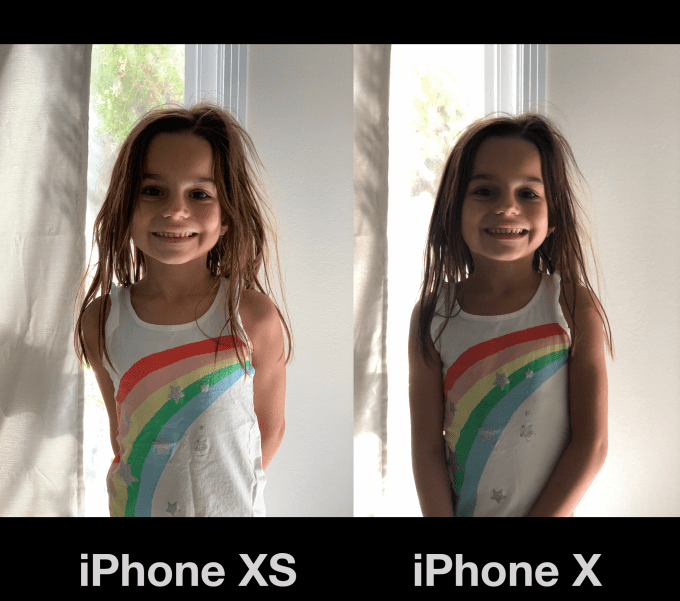
Smart HDR on the iPhone XS encompasses a bundle of techniques and technology including highlight recovery, rapid-firing the sensor, an OLED screen with much improved dynamic range and the Neural Engine/image signal processor combo. It’s now running faster sensors and offloading some of the work to the CPU, which enables firing off nearly two images for every one it used to in order to make sure that motion does not create ghosting in HDR images, it’s picking the sharpest image and merging the other frames into it in a smarter way and applying tone mapping that produces more even exposure and color in the roughest of lighting conditions.

iPhone XS shot, better range of tones, skintone and black point

iPhone X Shot, not a bad image at all, but blocking up of shadow detail, flatter skin tone and blue shift
Nearly every image you shoot on an iPhone XS or iPhone XS Max will have HDR applied to it. It does it so much that Apple has stopped labeling most images with HDR at all. There’s still a toggle to turn Smart HDR off if you wish, but by default it will trigger any time it feels it’s needed.
And that includes more types of shots that could not benefit from HDR before. Panoramic shots, for instance, as well as burst shots, low light photos and every frame of Live Photos is now processed.
The results for me have been massively improved quick snaps with no thought given to exposure or adjustments due to poor lighting. Your camera roll as a whole will just suddenly start looking like you’re a better picture taker, with no intervention from you. All of this is capped off by the fact that the OLED screens in the iPhone XS and XS Max have a significantly improved ability to display a range of color and brightness. So images will just plain look better on the wider gamut screen, which can display more of the P3 color space.
As far as Face ID goes, there has been no perceivable difference for me in speed or number of positives, but my facial model has been training on my iPhone X for a year. It’s starting fresh on iPhone XS. And I’ve always been lucky that Face ID has just worked for me most of the time. The gist of the improvements here are jumps in acquisition times and confirmation of the map to pattern match. There is also supposed to be improvements in off-angle recognition of your face, say when lying down or when your phone is flat on a desk. I tried a lot of different positions here and could never really definitively say that iPhone XS was better in this regard, though as I said above, it very likely takes training time to get it near the confidence levels that my iPhone X has stored away.
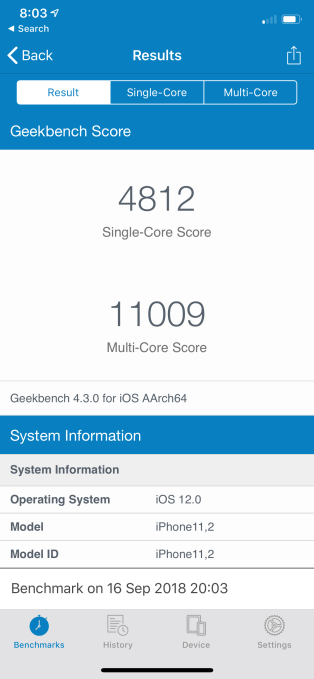
In terms of CPU performance the world’s first at-scale 7nm architecture has paid dividends. You can see from the iPhone XS benchmarks that it compares favorably to fast laptops and easily exceeds iPhone X performance.
The Neural Engine and better A12 chip has meant for better frame rates in intense games and AR, image searches, some small improvement in app launches. One easy way to demonstrate this is the video from the iScape app, captured on an iPhone X and an iPhone XS. You can see how jerky and FPS challenged the iPhone X is in a similar AR scenario. There is so much more overhead for AR experiences I know developers are going to be salivating for what they can do here.
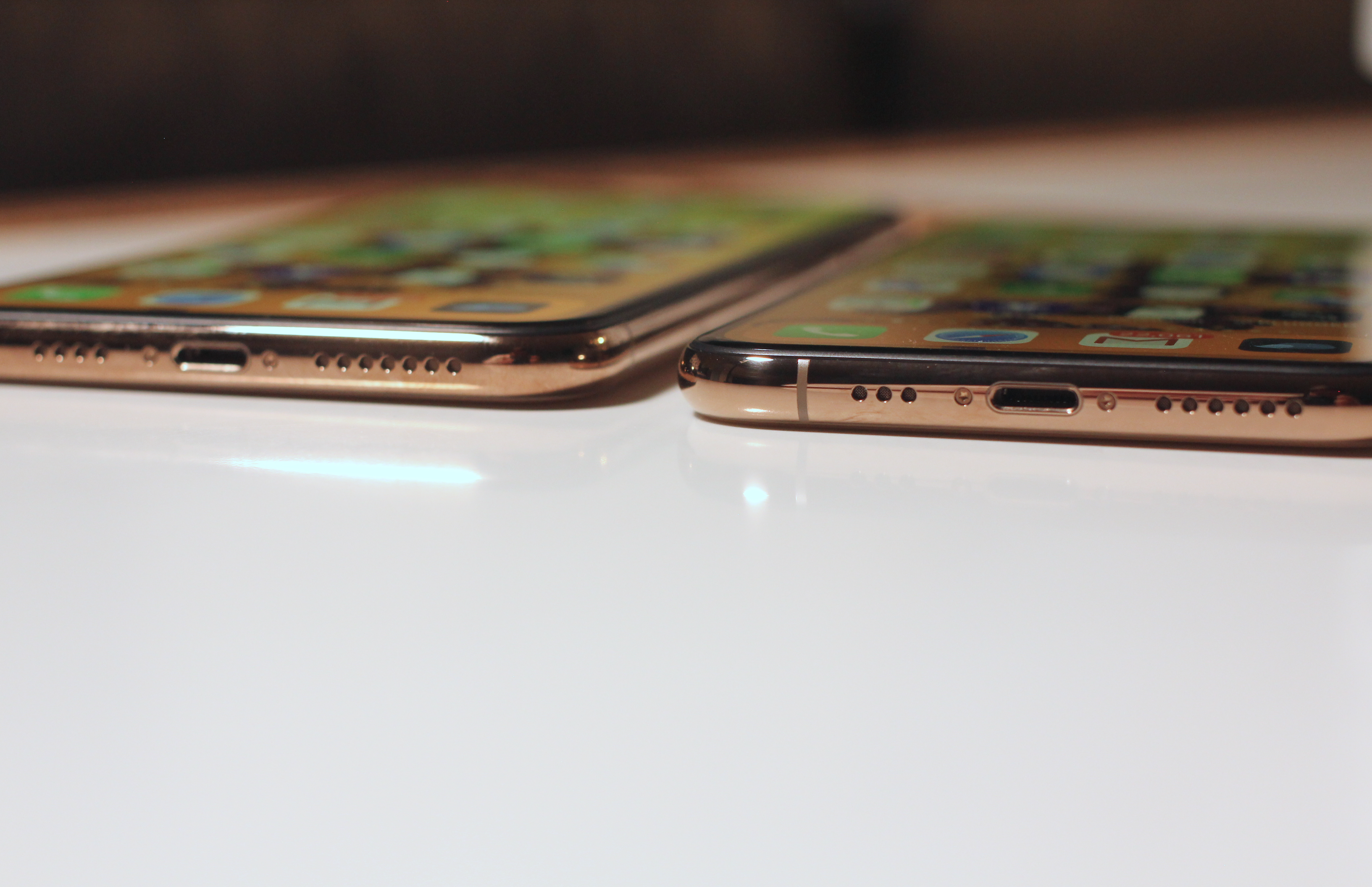
The stereo sound is impressive, surpassingly decent separation for a phone and definitely louder. The tradeoff is that you get asymmetrical speaker grills so if that kind of thing annoys you you’re welcome.
Every other year for the iPhone I see and hear the same things — that the middle years are unimpressive and not worthy of upgrading. And I get it, money matters, phones are our primary computer and we want the best bang for our buck. This year, as I mentioned at the outset, the iPhone X has created its own little pocket of uncertainty by still feeling a bit ahead of its time.
I don’t kid myself into thinking that we’re going to have an honest discussion about whether you want to upgrade from the iPhone X to iPhone XS or not. You’re either going to do it because you want to or you’re not going to do it because you don’t feel it’s a big enough improvement.
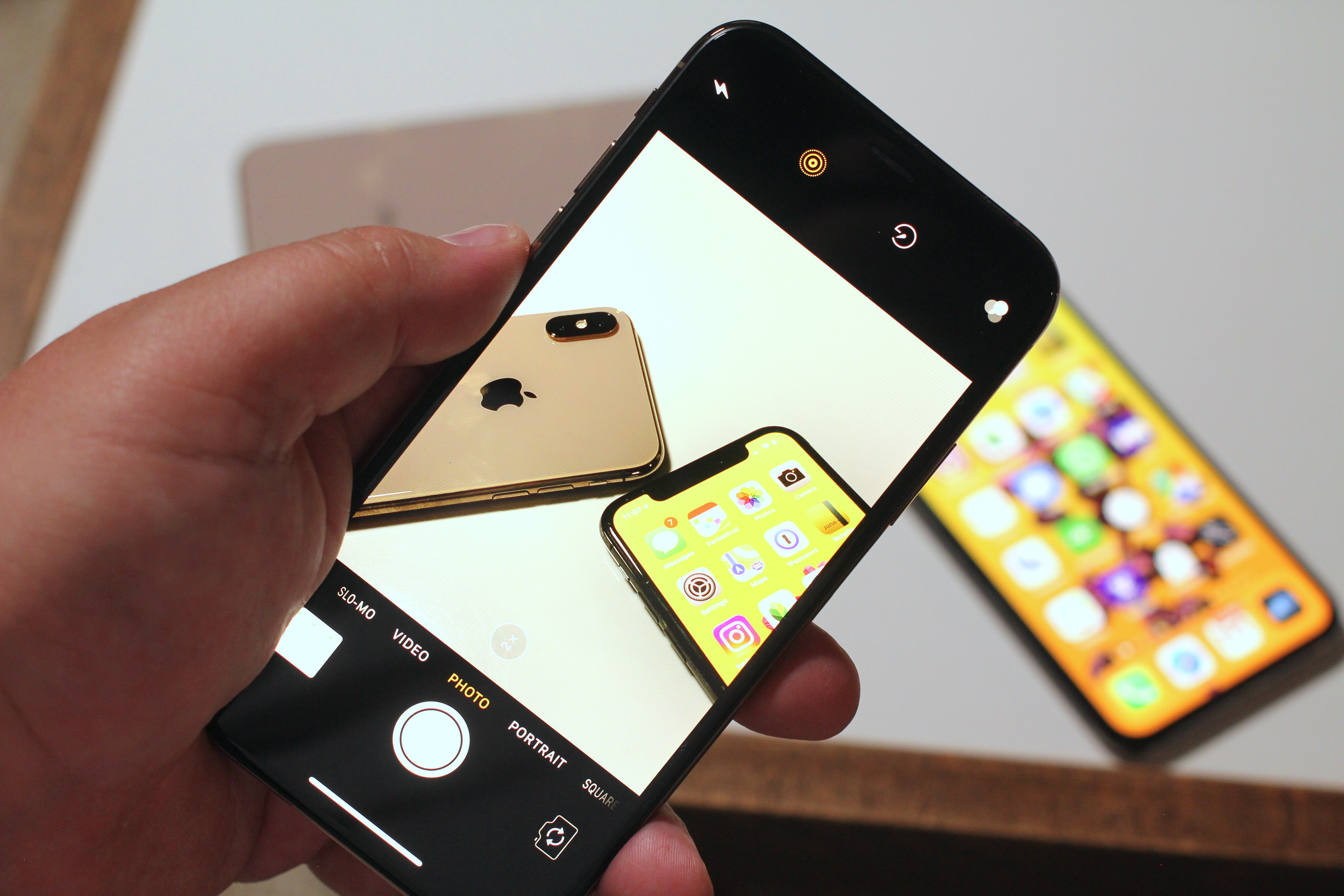
And I think Apple is completely fine with that because iPhone XS really isn’t targeted at iPhone X users at all, it’s targeted at the millions of people who are not on a gesture-first device that has Face ID. I’ve never been one to recommend someone upgrade every year anyway. Every two years is more than fine for most folks — unless you want the best camera, then do it.
And, given that Apple’s fairly bold talk about making sure that iPhones last as long as they can, I think that it is well into the era where it is planning on having a massive installed user base that rents iPhones from it on a monthly or yearly or biennial period. And it doesn’t care whether those phones are on their first, second or third owner, because that user base will need for-pay services that Apple can provide. And it seems to be moving in that direction already, with phones as old as the five-year-old iPhone 5s still getting iOS updates.
With the iPhone XS, we might just be seeing the true beginning of the iPhone-as-a-service era.